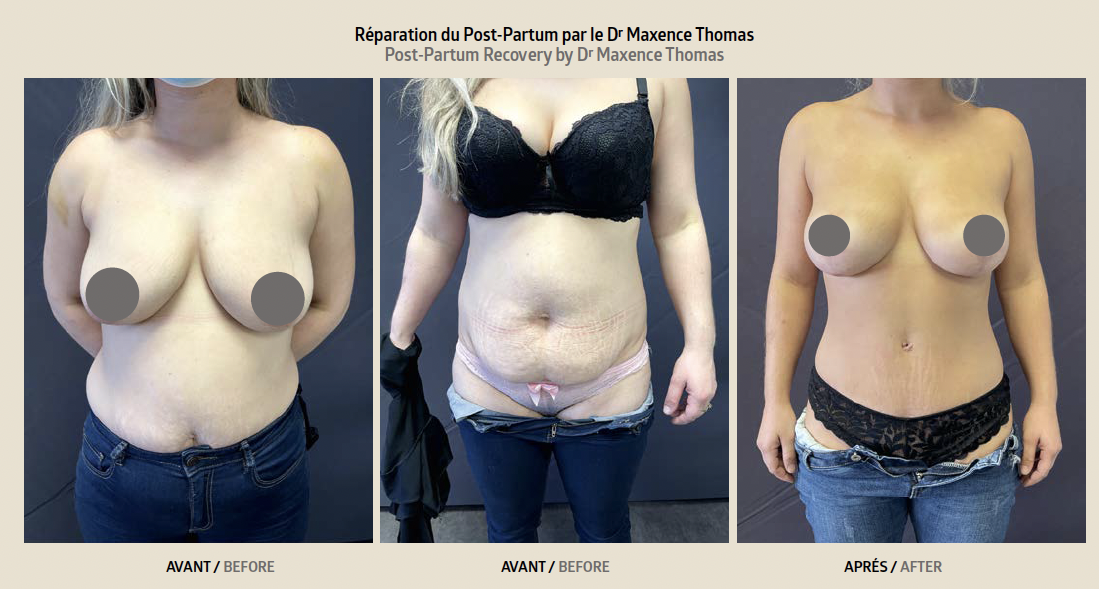Abdominal and breast surgery combined in a “Mommy Makeover”
Dr Maxence Thomas
The abdomen and the breasts are the two areas that suffer the most after pregnancy.
 The techniques and operating times are evolving, and we can now combine abdominal surgery with breast surgery without any increased risks.
The techniques and operating times are evolving, and we can now combine abdominal surgery with breast surgery without any increased risks.
Physiology
During pregnancy, the body goes through signifi cant changes due to the effect of hormones. The volume of the mammary glands increases significantly during breastfeeding, then the glands shrink away when breastfeeding stops. This often leaves the breasts empty and saggy.
On the abdomen, the skin and abdominal muscles relax to allow the volume of the uterus to expand. After childbirth, this leaves the skin and abdominal muscles distended.
The patients’ demands
For the abdomen
There may be some excess fat. The sub umbilical skin quality may be low: stretch marks, distended skin, “apron belly” that may or may not cover the pubis. The abdominal muscles may also be distended, and sometimes we see diastasis of the rectus abdominus muscles (a gap between the two sets of abdominal muscles). For the breasts
Mammary hypertrophy or hypotrophy, which are almost always associated with mammary ptosis.
 Surgical indications
Surgical indications
It is best to wait until six months after finishing breastfeeding for the last time if we want the aesthetic results to be stable.
For the abdomen:
An abdominoplasty with umbilical transposition allows us to tighten up the skin and reposition the belly button. It might be combined with diastasis repair, which helps tighten up the abdominal muscles. It can also be combined with liposuction. The procedure may be available on the national health service if the abdominal apron covers the pubis.
For the breasts:
In the case of mammary hypertrophy, we need to perform a breast reduction, which involves removing part of the mammary gland combined with a skin excision, resulting in an upside-down T-shaped scar around the areola, vertically downwards and underneath the breast. This procedure may be covered by social security if we remove more than 300g per breast.In the case of mammary hypotrophy, we need to increase the volume of the breasts, either by inserting breast implants or by lipofilling. Mammary ptosis almost always goes hand in hand with hypo or hypertrophy. In this case, a breast lift (mastopexy) is carried out alongside these surgeries. It leaves the same inverted T-shaped scar as a breast reduction.
Combination
We can combine abdominal surgery with breast surgery in one operation. The best example is the case shown (photos):A large abdominoplasty with umbilical transfer, carried out at the same time as a mastopexy combined with breast lipofilling. We rehang the skin on the belly and abdominals, then suck out the fat. This fat is then reinjected into the breasts, which have been lifted with a mastopexy, leaving an inverted T-shaped scar.
After effects
The patient usually needs to stay in hospital for one night, and needs to take two weeks off work. Combining techniques to treat postpartum body issues both optimises the recovery time after the operation and also makes the procedure cheaper for the patient.
 Dr Maxence Thomas: Aesthetic and plastic surgeon – Bordeaux. Laureat and former clinic head at the universities. Qualified in plastic, reconstructive and aesthetic surgery. Graduate and recipient of the DESC (high achievement) in Plastic, Reconstructive and Aesthetic Surgery.
Dr Maxence Thomas: Aesthetic and plastic surgeon – Bordeaux. Laureat and former clinic head at the universities. Qualified in plastic, reconstructive and aesthetic surgery. Graduate and recipient of the DESC (high achievement) in Plastic, Reconstructive and Aesthetic Surgery.
More Informations: drmaxencethomaschirurgieesthetique.com







